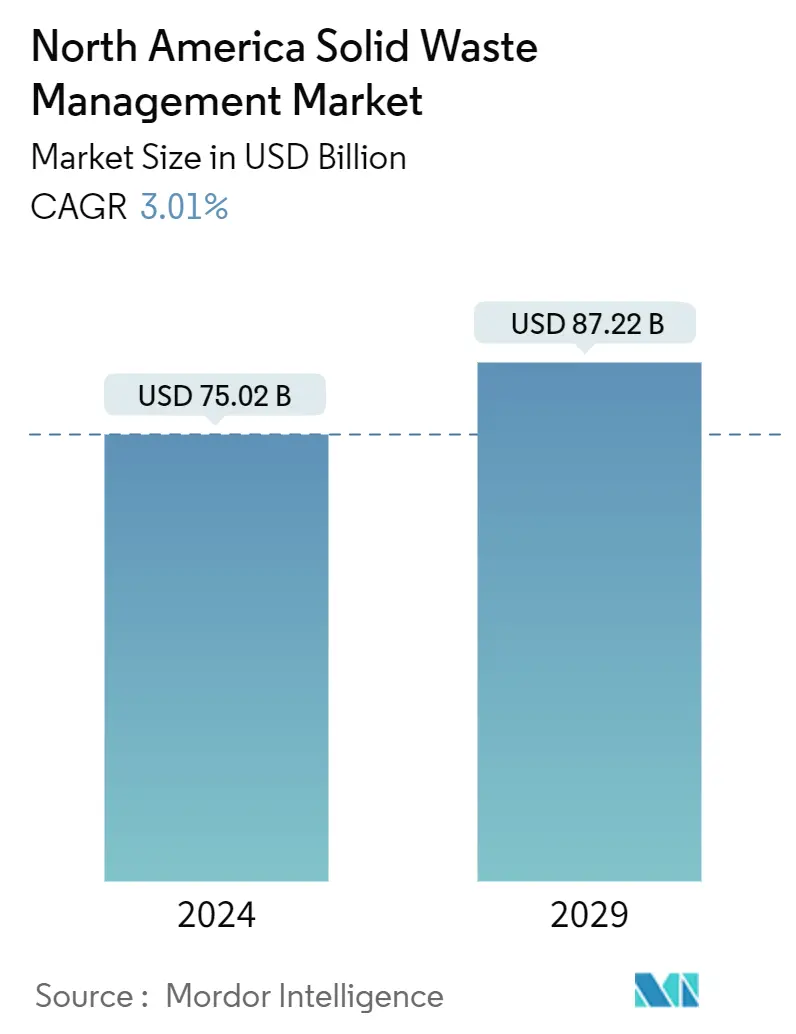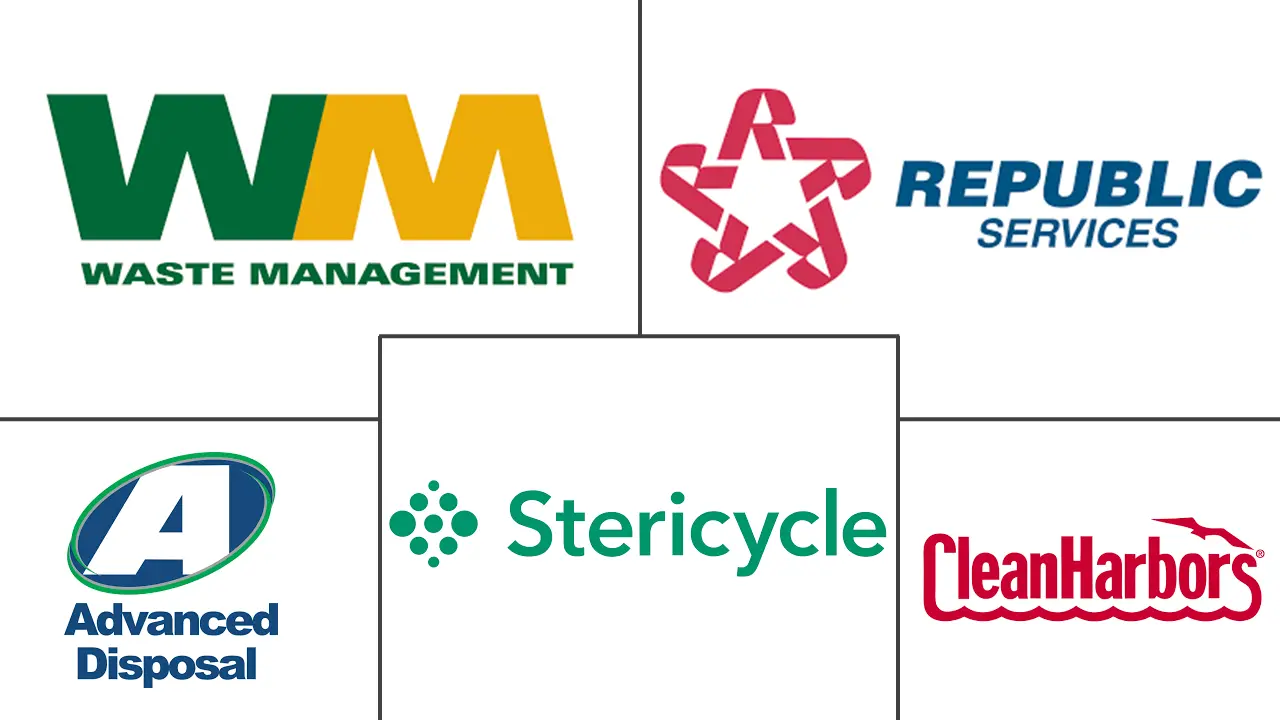Market Size of North America Solid Waste Management Industry

| Study Period | 2019-2029 |
| Market Size (2024) | USD 75.02 Billion |
| Market Size (2029) | USD 87.22 Billion |
| CAGR (2024 - 2029) | 3.01 % |
| Fastest Growing Market | Asia Pacific |
| Largest Market | North America |
Major Players
*Disclaimer: Major Players sorted in no particular order |
Need a report that reflects how COVID-19 has impacted this market and its growth?
North America Solid Waste Management Market Analysis
The North America Solid Waste Management Market size is estimated at USD 75.02 billion in 2024, and is expected to reach USD 87.22 billion by 2029, growing at a CAGR of 3.01% during the forecast period (2024-2029).
- In North America, solid waste management is a significant challenge due to the high population density and urbanization. The region generates a substantial amount of waste from residential, commercial, and industrial sources. To effectively manage this waste, comprehensive strategies and infrastructure are in place.
- One of the key trends in North America's solid waste management market is the emphasis on sustainable waste management practices. There is a growing focus on reducing waste generation through initiatives like recycling, composting, and waste reduction programs. Many cities and municipalities have implemented recycling programs to divert recyclable materials from landfills.
- Furthermore, regulatory frameworks play a crucial role in shaping the solid waste management market in North America. Government regulations at the federal, state, and local levels set standards for waste management practices, including landfill operations, waste collection, and recycling. Compliance with these regulations ensures the proper handling and disposal of solid waste.
- About half of the 300 million tons that are produced each year in the United States end up in landfills. Although the rate of MSW recycling in the United States has increased significantly since the 1960s, there has been little progress over the last decade, with recycling rates hovering around 30%. U.S. recycling rates are relatively low when compared with other countries, particularly in Europe.
- In terms of population, the United States is the biggest waste producer. The United States accounts for less than 5% of the global population but produces roughly 12% of global MSW and is the biggest generator of MSW per capita. On average, U.S. citizens produce more than 811 kilograms of waste per year.
- The United States produces more than 1,700 pounds of food, plastic, and hazardous waste per person.
- Each year, the country manages an estimated 35 million tons of hazardous materials. The United States saw nearly USD 9 billion in revenue for dangerous waste treatment and disposal in 2021, up 184% from 2000.
- The waste management industry in North America is also witnessing a shift towards a circular economy approach. The circular economy aims to minimize waste generation by promoting the recycling and reuse of materials. This approach not only reduces the environmental impact but also creates economic opportunities by turning waste into valuable resources.
- Additionally, public awareness and education programs are essential in promoting responsible waste management practices. Many organizations and local governments conduct educational campaigns to encourage individuals and businesses to adopt sustainable waste management habits, such as proper waste sorting and recycling.
- Overall, the solid waste management market in North America is evolving towards sustainable and innovative approaches. By focusing on waste reduction, recycling, and advanced technologies, the region is striving towards a more environmentally friendly and efficient waste management system.
North America Solid Waste Management Industry Segmentation
Solid waste management is basically the whole process of getting rid of solid waste. It involves collecting waste from different sources, transporting it, treating it, analyzing it, and then disposing of it.
The solid waste management market is segmented by waste type, disposal method, and geography. By waste type, the market is segmented into e-waste, plastic, hazardous, bio-medical, and other waste types; by disposal methods, the market is segmented into landfills, incineration, and recycling; and by region, the market is segmented into the United States, Canada, and Mexico.
The report offers market size and forecasts for the solid waste management market in terms of value (USD) for all the above segments.
| By Product Type | |
| Waste Disposal Equipment | |
| Waste Recycling and Sorting Equipment |
| By Waste Type | |
| Hazardous Waste | |
| Non-hazardous Waste |
| By collection type | |
| curbside pickup | |
| door-to-door collection | |
| community recycling programs |
| By End User | |
| Municipal Waste Management | |
| Healthcare | |
| Chemical | |
| Mining |
| By Region | |
| United States | |
| Canada | |
| Mexico |
North America Solid Waste Management Market Size Summary
The North America solid waste management market is experiencing significant growth, driven by the challenges of high population density and urbanization in the region. The market is evolving towards sustainable and innovative waste management practices, with a strong emphasis on reducing waste generation through recycling, composting, and waste reduction programs. Regulatory frameworks at federal, state, and local levels play a crucial role in shaping the market, ensuring compliance with standards for waste management practices. The industry is also witnessing a shift towards a circular economy, aiming to minimize waste generation by promoting the recycling and reuse of materials, which not only reduces environmental impact but also creates economic opportunities.
In addressing the plastic waste segment, North America is implementing various strategies to combat plastic pollution, including recycling programs and technological advancements in plastic recycling methods. Efforts to reduce single-use plastics and promote sustainable alternatives are gaining traction, supported by public awareness campaigns and government regulations. In Mexico, new waste management policies are encouraging municipalities to develop programs that reduce waste generation and promote recycling. Despite challenges, there is potential for growth in waste management infrastructure and technology adoption in Mexico. The competitive landscape in North America features major players like Waste Management Inc. and Republic Services Inc., offering a range of services from collection to recycling and landfill operations.
North America Solid Waste Management Market Size - Table of Contents
-
1. MARKET DYNAMICS AND INSIGHTS
-
1.1 Market Overview
-
1.2 Market Dynamics
-
1.2.1 Market Drivers
-
1.2.1.1 Increasing awareness among consumers
-
1.2.1.2 Environmental concerns and sustainability
-
-
1.2.2 Market Restraints
-
1.2.2.1 The cost of production and transportation
-
1.2.2.2 Regulations and quality standards
-
-
1.2.3 Market Opportunities
-
1.2.3.1 The demand for sustainable solutions
-
1.2.3.2 Regional and local market expansion driving the market
-
-
-
1.3 Industry Attractiveness - Porter's Five Forces Analysis
-
1.3.1 Bargaining Power of Suppliers
-
1.3.2 Bargaining Power of Buyers
-
1.3.3 Threat of New Entrants
-
1.3.4 Threat of Substitutes
-
1.3.5 Intensity of Competitive Rivalry
-
-
-
2. MARKET SEGMENTATION
-
2.1 By Product Type
-
2.1.1 Waste Disposal Equipment
-
2.1.2 Waste Recycling and Sorting Equipment
-
-
2.2 By Waste Type
-
2.2.1 Hazardous Waste
-
2.2.2 Non-hazardous Waste
-
-
2.3 By collection type
-
2.3.1 curbside pickup
-
2.3.2 door-to-door collection
-
2.3.3 community recycling programs
-
-
2.4 By End User
-
2.4.1 Municipal Waste Management
-
2.4.2 Healthcare
-
2.4.3 Chemical
-
2.4.4 Mining
-
-
2.5 By Region
-
2.5.1 United States
-
2.5.2 Canada
-
2.5.3 Mexico
-
-
North America Solid Waste Management Market Size FAQs
How big is the North America Solid Waste Management Market?
The North America Solid Waste Management Market size is expected to reach USD 75.02 billion in 2024 and grow at a CAGR of 3.01% to reach USD 87.22 billion by 2029.
What is the current North America Solid Waste Management Market size?
In 2024, the North America Solid Waste Management Market size is expected to reach USD 75.02 billion.

